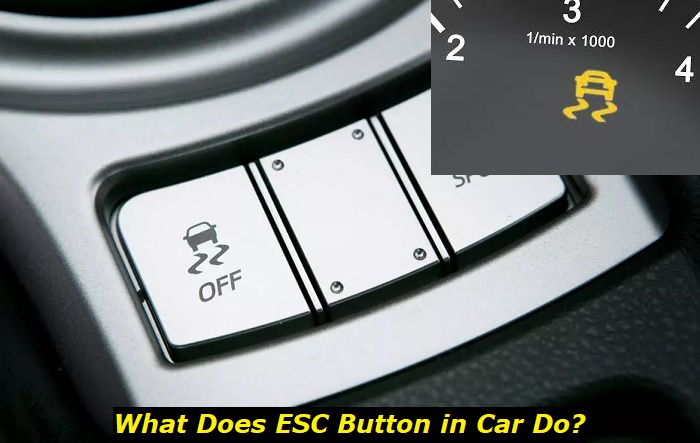Have you ever noticed the ESC button in your car and wondered what it does? The ESC button stands for Electronic Stability Control, and it's an essential safety feature that helps you stay in control when driving on wet or slippery roads.
It works by detecting when your car is starting to lose traction and automatically applies brakes to specific wheels to help keep you steady. In this article, we'll explain how ESC works, why it's important, and how you can use it to improve your overall driving experience.

What is the Electronic Stability Control (ESC) system?
The Electronic Stability Control (ESC) system is an automated technology that helps drivers maintain control of their vehicles by automatically applying brakes to individual wheels and reducing engine power when it senses the vehicle going off-course. This advanced safety feature has been proven to reduce the chances of skidding, loss of control in hazardous driving conditions, and even rollover crashes.
Studies have shown that vehicles equipped with ESC are 25% less likely to be involved in a fatal accident than those without it. Despite its wide availability, many drivers remain unaware of this vital safety feature. Understanding how ESC works and its importance can help drivers make more informed decisions about the safety of their vehicles.
ESC is designed to detect when a driver is losing control over the vehicle's direction and intervene with corrective measures such as applying brakes to individual wheels or reducing engine power. It does this by continuously monitoring steering inputs, vehicle speed, yaw rate, and lateral acceleration.
When it senses the vehicle is going off course, it applies brakes to one or more of the wheels and reduces engine power in order to bring the vehicle back onto its intended path. The system can also be manually overridden by the driver, allowing them to take full control of their vehicle if necessary.
The ESC system is a vital safety feature that can help reduce the chances of vehicle accidents and rollovers. It can also assist drivers in navigating hazardous driving conditions such as icy roads or strong winds. Despite its importance, many drivers remain unaware of this advanced technology and the benefits it provides. Understanding how ESC works and it's potential to save lives is key to making informed decisions about the safety of a vehicle.
This technology is becoming increasingly prevalent as more vehicles come standard with ESC, and it should be considered an essential feature when shopping for a new vehicle. With its lifesaving potential, the Electronic Stability Control system can be an invaluable addition to any driver's safety arsenal.
What surfaces can the ESC system work on?
The ESC system is designed to work on a variety of surfaces, particularly those that are smooth and nonporous. This includes concrete, asphalt, cement, tile, marble, and other hard surfaces. It can also be used on softer surfaces such as grass and dirt roads. The ESC system has been tested in varying environmental conditions, including wetter climates and higher temperatures.
The system is designed to be able to handle a range of surface conditions, from dry to wet and cold to hot. It has been verified that the ESC system works with all types of surfaces and can provide reliable traction control in any environment. This versatility makes it an ideal product for use in a variety of applications.
In addition, the ESC system has been designed with safety in mind. Its advanced sensors monitor the environment around it and adjust its settings accordingly. The system is designed to respond quickly to changing conditions and can be set up to automatically apply brakes if it detects skidding or drifting. This ensures that your vehicle stays safe even in low-friction scenarios.
What does the ESC light indicator mean?
The ESC light indicator is usually a yellow or orange car shape with curved tire prints running diagonally under the car. When this light appears on your dashboard, it means that the Electronic Stability Control system is active and working as intended. If the ESC light is blinking or illuminated continuously, it may indicate a malfunction with the system, and you should have it checked out by a professional mechanic.
So what does the ESC button do if it is turned on or off
If the ESC button is turned on, it will work to help keep the car stable and reduce skidding. It does this by reducing engine power, applying brakes selectively to individual wheels, and aiding with steering. If the ESC button is turned off, then the car will not have any of these features available in order to help maintain stability and reduce skidding. This means that drivers will need to be more careful and attentive when driving in wet or icy conditions, as they may not have the assistance of the ESC system if it is turned off.
Additionally, some car models may require that the ESC system is on at all times in order for them to operate properly and safely, so it is important to make sure that the ESC system is turned on if the vehicle requires it. It is always best to check with your car owner's manual or manufacturer's website to determine if your particular model requires you to use the ESC system when driving.
What is the difference between ESP and ESC?
There is no difference between ESP and ESC- they both refer to the same feature. ESP stands for Electronic Stability Program (or Programme), while ESC stands for Electronic Stability Control. Different car manufacturers may use either acronym to refer to the same feature.
When should I turn the ESC system off?
The ESC system should not be turned off unless it is absolutely necessary. The ESC system is designed to provide extra safety and stability when driving in difficult conditions, so it is important to keep it turned on as much as possible. In certain cases, such as racing or off-road events, it may be necessary to turn off the ESC system in order for the vehicle to perform properly. Be sure you have the necessary skills and training in order to do this safely. Unless you are a professional racer or off-roader, it is generally best to keep the ESC system on.
What issues may cause your ESC system to turn off?
The most common reason is a low battery level or an electrical fault in the system. Other issues that may cause the ESC system to turn off include faulty wiring, an issue with the speed sensor, or a problem with the electronic control unit (ECU). If you suspect any of these issues are causing your ESC system to turn off, then it's important to have it inspected and repaired as soon as possible.
Additionally, you should also check for any loose or damaged components in the system that could be causing the issue. It's important to ensure that all parts of the ESC system are functioning correctly in order to avoid further damage or dangerous driving conditions. If your ESC is still turning off after inspecting these components and ensuring all connections are secure, then it may be time to call a professional for further assistance.
Bottom Line
The ESC system is a valuable safety feature that can help reduce the chances of vehicle accidents and rollovers. It is important to understand how it works and its lifesaving potential in order to make informed decisions about automotive safety. The ESC light indicator will let you know when the system is active, but be sure to check your car owner's manual or manufacturer's website to determine if the ESC system needs to be on at all times.
As a general rule, it is best to keep the ESC system on unless it is absolutely necessary to turn it off. Doing so can help ensure that you and your passengers remain safe while out on the road.
About the authors
The CarAraC research team is composed of seasoned auto mechanics and automotive industry professionals, including individuals with advanced degrees and certifications in their field. Our team members boast prestigious credentials, reflecting their extensive knowledge and skills. These qualifications include: IMI: Institute of the Motor Industry, ASE-Certified Master Automobile Technicians; Coventry University, Graduate of MA in Automotive Journalism; Politecnico di Torino, Italy, MS Automotive Engineering; Ss. Cyril and Methodius University in Skopje, Mechanical University in Skopje; TOC Automotive College; DHA Suffa University, Department of Mechanical Engineering






Add comment